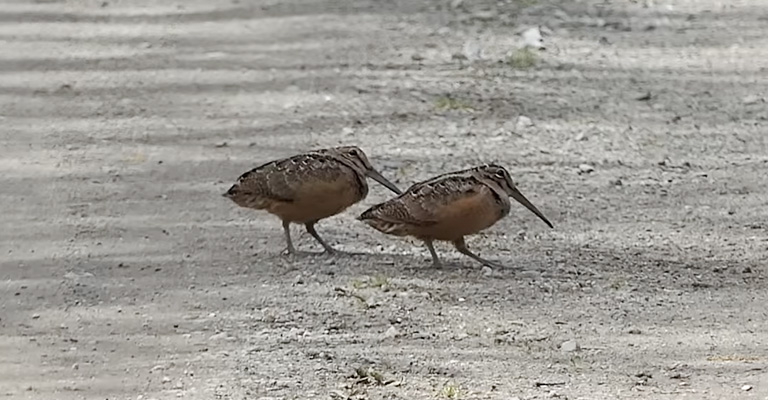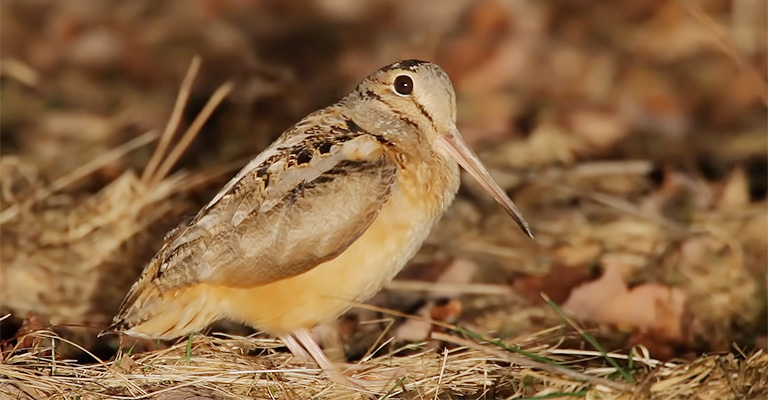In the dim twilight of the forest, a peculiar dance unfolds, captivating the eyes and piquing the curiosity of those fortunate enough to witness it. The woodcock, a unique and elusive bird, engages in a mesmerizing display known as the “sky dance.”
But why do woodcock birds dance? What purpose does this dance serve in their lives? In this article, we delve into the fascinating world of woodcock birds and explore the reasons behind their captivating dance.
From courtship rituals to territorial displays, the woodcock’s dance holds clues to their reproductive success and survival.
Join us as we unravel the mystery behind this extraordinary behavior, shedding light on the intricate interplay between nature, instinct, and the timeless allure of dance in the avian realm.

Why Do Woodcock Birds Dance?
Woodcock birds engage in a unique courtship display known as the “sky dance” or “roding.” The woodcock’s dance serves multiple purposes, including attracting mates, establishing territories, communicating information, displaying physical prowess, and assessing potential mates.
It is a fascinating behavior that plays a crucial role in the reproductive success and survival of woodcock populations. There are a few reasons why woodcocks perform this elaborate dance:
Attracting Mates
The primary purpose of the woodcock’s dance is to attract a mate. Male woodcocks perform their sky dance during the breeding season to impress females. The dance involves spiraling upward into the sky, followed by a series of zigzagging flights and vocalizations.
This display showcases the male’s fitness, agility, and overall health, which can be attractive to potential mates.
Territory Establishment
The sky dance also serves as a means for males to establish their territories. By performing their display in a specific area, they communicate to other males that the territory is already claimed. This helps reduce conflicts and competition between males.
Communication
The sky dance is a form of communication between male and female woodcocks. The vocalizations and flight patterns during the dance convey information about the male’s location, readiness to mate, and overall condition.
Females observe these displays and use them to assess potential mates.
Species Recognition
The sky dance is unique to woodcocks, and it helps in species recognition. By performing this distinctive courtship display, woodcocks can identify and attract individuals of their own species, ensuring successful reproduction.
Overall, the woodcock’s dance is a fascinating behavior that serves multiple purposes, including attracting mates, establishing territories, communicating information, and ensuring successful reproduction within their species.
Displaying Physical Prowess

The sky dance allows male woodcocks to showcase their physical abilities and agility. The intricate flight patterns, including sudden twists and turns, demonstrate their strength, coordination, and control.
This can be appealing to females, as it indicates the male’s ability to navigate their environment and potentially provide good genes to their offspring.
Assessing Potential Mates
The dance not only helps females evaluate males but also allows males to assess the quality of potential mates. By observing a female’s response to their display, males can gauge her interest and receptiveness.
This helps them choose a suitable partner for successful reproduction.
Establishing Dominance Hierarchy
In addition to territory establishment, the sky dance can also establish a dominance hierarchy among males. Males with more impressive displays may be perceived as more dominant and have a higher chance of attracting mates.
This hierarchy can reduce physical confrontations between males and maintain order within the population.
Stimulating Breeding Behavior
The sky dance serves as a form of courtship behavior that stimulates breeding in woodcocks. The elaborate display, combined with vocalizations, helps create an atmosphere conducive to mating.
The dance acts as a precursor to the actual mating process, signaling to both males and females that they are ready to engage in reproductive activities.
Genetic Diversity
By performing the sky dance, woodcocks increase the chances of genetic diversity within the population. Females have the opportunity to select mates based on their display quality, which can lead to the selection of genetically diverse partners.
This genetic diversity is beneficial for the long-term survival and adaptability of the species.
Do All Woodcock Birds Dance?

Yes, all woodcock birds engage in some form of courtship display, commonly known as the “sky dance” or “roding.” This behavior is primarily exhibited by male woodcocks during the breeding season as a means to attract females.
The specific details of the dance may vary slightly among different woodcock species, but the overall purpose and function remain the same. The sky dance is a characteristic behavior of woodcocks and is an integral part of their reproductive behavior.
How Does the Woodcock Bird Dance Look Like?
The woodcock bird’s dance, also known as the sky dance or roding, is a fascinating display characterized by a series of unique movements and vocalizations. Here is a description of how the woodcock bird’s dance typically looks:
Takeoff
The dance usually begins with the male woodcock on the ground. He takes off into the air, often at dusk or dawn, using a short, rapid flight to gain altitude.
Spiraling Ascent
Once airborne, the male woodcock starts a spiraling ascent, flying in a circular or corkscrew-like pattern. This spiral flight can take the bird up to several hundred feet into the air.
Zigzagging Flight
After reaching a certain height, the woodcock transitions into a zigzagging flight pattern. It flies in a series of quick, erratic movements, changing direction rapidly.
This flight pattern is thought to be a way to display agility and attract the attention of potential mates.
Vocalizations
Throughout the dance, the male woodcock produces a distinctive vocalization known as the “peent” call. This call is a nasal, buzzy sound that is repeated several times. The peent call helps attract females and communicate the male’s presence and readiness to mate.
Descending Back to the Ground
After performing the zigzagging flight and vocalizations, the male woodcock descends back to the ground in a controlled manner. It may land near the same spot where it took off or in a different location within its territory.
Note that the woodcock’s dance can vary slightly among individuals and populations, but the general sequence of takeoff, spiraling ascent, zigzagging flight, vocalizations, and descent is characteristic of the woodcock’s courtship display.
The dance is a visually captivating and acoustically distinct behavior that helps attract mates and establish breeding territories.
What Is Special About a Woodcock?

Woodcocks are fascinating birds with several unique characteristics and behaviors. Their camouflaged plumage, long probing bill, unique eyesight, nocturnal behavior, elaborate courtship display, and long-distance migration make them a fascinating species to study. Here are seven interesting facts about woodcocks:
Camouflaged Plumage
Woodcocks have evolved remarkable camouflage to blend in with their woodland habitats. Their mottled brown, black, and gray plumage, combined with intricate patterns, helps them remain hidden from predators and blend seamlessly with the forest floor.
Long, Probing Bill
One of the most distinctive features of woodcocks is their long, probing bill. The bill is flexible and sensitive, allowing them to probe the soil for earthworms and other invertebrates, which make up the majority of their diet.
The tip of the bill is equipped with specialized nerve endings that help them detect prey underground.
Unique Eyesight
Woodcocks have a unique adaptation in their eyesight. Their large, dark eyes are positioned high on their head, providing them with a wide field of vision. This allows them to keep an eye out for predators while their bill is probing the ground for food.
Unusual Courtship Display
Woodcocks are known for their elaborate courtship display, often referred to as the “sky dance” or “roding.” Males perform this display during the breeding season to attract females.
It involves spiraling ascents, zigzagging flights, and vocalizations, showcasing the male’s agility and fitness.
Nocturnal Behavior
Woodcocks are primarily nocturnal birds, meaning they are most active during the night. They have adapted to low-light conditions with their large eyes and excellent night vision. This behavior helps them avoid predators and find food more efficiently.
Long-Distance Migration
Woodcocks are remarkable migratory birds. Some populations undertake long-distance migrations, traveling thousands of miles between their breeding grounds and wintering areas.
They navigate using a combination of celestial cues, landmarks, and magnetic fields.
Unique Breeding Habitat
Woodcocks have specific habitat requirements for breeding. They prefer moist, dense woodlands with a mix of open areas and thick vegetation. These habitats provide cover for nesting and foraging, as well as suitable conditions for their courtship display.
FAQs
Male woodcocks perform the sky dance as a courtship display to attract females. The elaborate flight patterns and vocalizations showcase the male’s fitness, agility, and overall health, which can be attractive to potential mates.
The woodcock dance is an instinctive behavior that is genetically programmed. Young woodcocks observe and learn the dance by watching adult males perform it during the breeding season.
Woodcocks typically perform their dance during the breeding season, which varies depending on the geographic location. In many regions, the dance occurs in the early spring, often at dusk or dawn.
No, female woodcocks do not typically perform the sky dance. It is primarily a behavior exhibited by male woodcocks to attract females. Female woodcocks observe the male’s dance and vocalizations and use them as cues to assess potential mates.
Yes, woodcock dances can be observed by humans, but they can be challenging to witness due to their nocturnal nature and specific breeding habitats.
To increase the chances of observing the dance, birdwatchers, and researchers often stake out known woodcock breeding areas during the appropriate season.
Parting Words
As we conclude our exploration of the woodcock’s dance, we are left with a sense of wonder and admiration for the intricate behaviors exhibited by these remarkable birds.
The sky dance serves as a testament to the beauty and complexity of nature, reminding us of the diverse strategies employed by different species to ensure their survival and reproductive success.
While we have gained some insights into the reasons behind the woodcock’s dance, there is still much to learn and discover about these enigmatic creatures.
The ongoing research and observation of their behaviors continue to unravel the intricacies of their lives, offering a deeper understanding of the natural world.
Witnessing this ethereal display is a reminder of the hidden wonders that unfold in the depths of nature, inviting us to appreciate and protect the delicate balance of life that surrounds us.